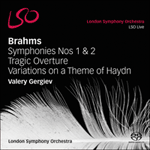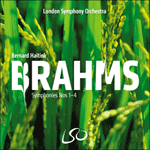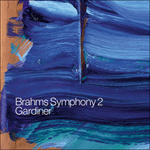
Welcome to Hyperion Records, a British classical label devoted to presenting high-quality recordings of music of all styles and from all periods from the twelfth century to the twenty-first.
Hyperion offers both CDs, and downloads in a number of formats. The site is also available in several languages.
Please use the dropdown buttons to set your preferred options, or use the checkbox to accept the defaults.

Improvisation takes on an altogether different character in the deeply reflective second movement—the emotional core of the work. One notices immediately the seamlessly developing main idea—12 bars of concentrated motivic evolution in which the music seems almost to speak, and that marks yet another stage in symphonic evolution. A second section in 12/8 metre introduces a stately dance-like progression before the weighty and cumulative development of the main idea takes over—a passage that is bound to leave the listener with much more convulsive images of nature. The dance has an almost neo-classical character, a quality that emerges much more distinctly in the third movement. Its deceptively straightforward ‘Allegretto grazioso’ marking (an obvious successor to the ‘Menuetto’ movement of the first serenade—both are G major movements in D major works) is subjected to really extreme rhythmic variation, in which the 3/4 music is forced into 2/4 metre, and then into 3/8 metre, each related to the basic pulse by metrical transition of delightful sophistication. Brahms seems to have been more confident in the success of this work and it was premiered at the Gesellschaft der Musikfreunde with the Vienna Philharmonic under Hans Richter, on 30 December 1877, to his complete satisfaction.
from notes by Michael Musgrave © 2013
L’improvisation prend un tour tout différent dans le second mouvement, profondément introspectif—le coeur émotionnel de la partition. On remarque immédiatement l’idée principale, qui se déploie d’un seul tenant—12 mesures d’une évolution motivique concentrée, où la musique semble presque parler, et qui marque encore une nouvelle étape dans l’évolution symphonique. Une seconde section dans une mesure à 12/8 introduit une progression majestueuse dans l’esprit de la danse, avant que le développement pesant et cumulatif de l’idée principale ne prenne le dessus—un passage destiné imprégner l’auditeur d’images de la nature plus convulsives. La danse a un caractère presque néo-classique, qui transparaît plus encore dans le troisième mouvement. Son intitulé trompeusement simple d’«Allegretto grazioso» (un successeur évident du «Menuetto» de la Première Sérénade—tous deux sont des mouvements en sol majeur au sein d’oeuvres en ré majeur) est en réalité soumis à des variations rythmiques extrêmes, où une musique à 3/4 est pliée à une mesure à 2/4, puis à une mesure à 3/8, chacune reliée à la pulsation de base par une transition métrique d’une délicieuse subtilité. Brahms semble avoir eu plus confiance dans le succès de cette oeuvre, qui fut jouée pour la première fois à la Gesellschaft der Musikfreunde par l’Orchestre philharmonique de Vienne sous la direction de Hans Richter, le 30 décembre 1877, à sa totale satisfaction.
extrait des notes rédigées par Michael Musgrave © 2013
Français: Claire Delamarche
Improvisation bedeutet in dem zutiefst besinnlichen zweiten Satz—dem emotionellen Kern des Werkes—etwas völlig anderes. Man wird sofort von dem nahtlos fortspinnenden Hauptgedanken gefangen—12 Takte mit konzentrierter motivischer Evolution, in der die Musik fast zu sprechen scheint. Dieses Fortspinnen stellt einen weiteren Schritt in der Entwicklung sinfonischer Kompositionen dar. Der zweite Abschnitt, im 12/8-Takt, stellt eine feierlich tänzerische Folge vor, bis die gewichtige und kumulative Durchführung des Hauptgedankens beginnt—eine Passage, die bei den Hörern wohl viel stürmischere Naturbilder assoziiert. Der Tanz hat einen fast neoklassischen Charakter, eine Eigenschaft, die viel deutlicher im dritten Satz zum Vorschein kommt. Trotz seiner scheinbar unkomplizierten Überschrift „Allegretto grazioso“ (ein offensichtlicher Nachfolger des mit „Quasi Menuetto“ überschriebenen Satzes aus der 1. Serenade—beide Sätze stehen in G-Dur in einem Werk in D-Dur) gibt es hier richtig extreme rhythmische Schwankungen: Musik im 3/4-Takt wird in einen 2/4-Takt gedrängt und dann in einen 3/8-Takt, jedes Mal durch handwerklich geschliffenen metrischen Übergang bei Beibehaltung des Grundpulses. Brahms scheint mehr Vertrauen in den Erfolg dieses Werkes gehabt zu haben. Es wurde zu seiner vollen Zufriedenheit am 30. Dezember 1877 in der Gesellschaft der Musikfreunde von den Wiener Philharmonikern unter Hans Richter uraufgeführt.
aus dem Begleittext von Michael Musgrave © 2013
Deutsch: Elke Hockings
 Brahms: Symphonies Nos 1 & 2 Brahms: Symphonies Nos 1 & 2Valery Gergiev begins his Brahms symphony cycle with recordings of the first two Symphonies, the Tragic Overture and the Haydn Variations. The epic Symphony No 1, portraying dignity and grandeur, was ecstatically received at its premier in 1876, a ...» More |
 Brahms: Symphonies Nos 1-4 Brahms: Symphonies Nos 1-4This acclaimed cycle of Brahms symphonies—BBC Radio 3 Building a Library's 'First Choice' in January 2005—has been gloriously remastered and is now available for super-hi-res download.» More |
 Brahms: Symphony No 2 & Alto Rhapsody Brahms: Symphony No 2 & Alto Rhapsody'This is characterful music-making, complex and subtle' (Gramophone)  BBC Music Magazine» More BBC Music Magazine» More |

